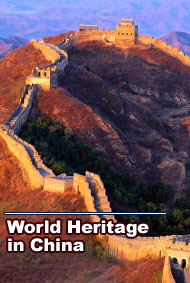
|
|
|
The Ancient City of Pingyao (Central Shanxi Province)
b. Cultural Heritage The original purpose of King Xuan for building Pingyao was to withstand the attacks of the nomads of the north. Afterwards, Pingyao was developed into a multi-functional city, the starting place of commercial business in Shanxi and the birthplace of China's first rudimentary form of a modern bank. Peiyao also retains most of its ancient charm in buildings like the Temple of Confucius, the Qingxu Temple, and a great number of residential buildings. The Old Town of Pingyao was constructed according to the traditional planning and building style of the Han ethnic group, and was designed according to the functions of its different parts. Four large streets, eight smaller ones, and 72 lanes make a neat grid. Symmetrically arranged along an axis, the private houses were constructed either in the style of courtyard houses or in the style of manmade-cave houses, all with local features. Today, Pingyao still has 3,797 courtyard houses, 400 of them especially well preserved. In addition, richly decorated temples and shops are scattered all over the town. These old buildings bring back a scene of the flourishing town of Pingyao as one of the most prosperous commercial centers during the Ming and Qing periods. The Zhenguo Temple, located in the northeast part of the city, was built 1,000 years ago, and its Hall of Ten Thousand Buddhas (Wan-fo Hall) is the third-oldest existing wooden building in China. The painted statues from the Five Dynasties period (907-960) inside the Wanfo Hall are recognized as precious sculptures. The Shuanglin Temple, with its ten halls, is located in the southwest part of the town. It was rebuilt in 571, during the Northern Qi Dynasty (550-577). As the temple houses more than 2,000 painted clay statues from the Yuan Dynasty (1271-1368) through the Ming Dynasty, it is known as the Treasure House of Painted Sculptures. Other treasures in Pingyao include the Hall of Great Achievements (Da-cheng-dian) in the Temple of Confucius (Wen-miao), reconstructed in 1163, and the Qingxu Temple, originally constructed in 657. c. Notabilities The time-honored city of Pingyao is also notable for producing famous figures in Chinese history: Sun Sheng, an upright historian in defiance of threats of execution in the 19th century; Sun Kang, a diligent scholar of ancient times famed for reading in the reflected light of the snow; Hou Wailu, a top contemporary expert in history; Wang Yao, a top Chinese literature specialist; the linguist Hou Jingyi and many top-notch professionals in arts. Notables of Pingyao also include: Sun Chu (218-293), a scholar of the Western Jin Dynasty, famed for his poems. He was appointed to several official positions, including that of prefect of Fengyi. The most quoted work by Sun Chu is Valediction at the Departure of Several Generals. Sun Chuo (314-371), one of the representative metaphysical poets of the Eastern Jin Dynasty. Erudite and reclusive, he lived a cloistered life in Zhejiang for ten years before being invited to work as minister in the government. His most famous works include "Ode to Seclusion" and "Ode to Mt. Tiantai". d. Legends and Stories The parapet, or the Maiden's Wall, is named after a little girl who saved a workman's life at the cost of her own. Legend has it that the girl used to sit on the city wall every day watching her grandpa help to build the wall. One day, when she saw a fatigued worker swaggering by the edge of the wall, she came up to push him back to the safe place but fell off herself. In grief, the workers built up a smaller parapet on the wall to commemorate her. |